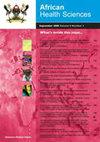Relationship between antimicrobial resistance and virulence factors in uropathogenic Escherichia coli isolates from Ramadi, Iraq: phenotype and genotype identification
IF 0.9
4区 医学
Q3 MEDICINE, GENERAL & INTERNAL
引用次数: 0
Abstract
Background: Uropathogenic Escherichia coli (UPEC) is the most predominant pathogen that causes severe urinary tract infections (UTIs). Their therapeutic options are limited due to the rising of antibiotic resistance. Objective: The aim of the study was to evaluate the level of antibiotic resistance profile, redundancy of virulence genes, and their correlation. Methods: 41 UPEC isolates were collected from patients diagnosed with UTI, identified by the standard microbiological analysis, and tested for susceptibility to 12 antibiotic agents using the Kirby-Bauer method. The ability of UPEC isolates to produce biofilm, hemolyze and cause clumping of blood was determined. Virulence genes were detected by PCR analysis. Results: The percentage of UPEC isolates was higher in females (78.1%) than in males (21.9%). UPEC isolates showed a high degree of resistance towards Ceftriaxone (90.2%), Cefepime (90.2%), Ciprofloxacin (82.9%), Levofloxacin (82.9%), and Trimethoprim-Sulfamethoxazole (80.4%). Biofilm formation (87.8%) and hemagglutinin activity (80.4%) were the most predominant virulence markers expressed in UPEC and showed a high degree of correlation with the antibiotic resistance profile. PCR analysis showed that fimH (85.3%) was the most prevalent gene detected in UPEC isolates, followed by aac3-II (80.4%) among the five genes tested, blaTEM, aac3-II, sul2, hlyA, and fimH. The correlation between antibiotic resistant patterns and the presence aac3-II gene was significantly high. The resistance to the sulfonamides’ combined antibiotic was highly correlated with the presence of sulf2 gene. Conclusion: Antimicrobial resistance was significantly linked to phenotypic and genotypic virulence factors. These results will aid in elucidating the pathogenicity of UTIs and guiding treatment decisions. Keywords: UPEC resistance profile; virulence factor; Biofilm formation; hemagglutinin; hemolysin.伊拉克拉马迪市尿路致病性大肠杆菌耐药性与毒力因子的关系:表型和基因型鉴定
背景:尿路致病性大肠杆菌(UPEC)是引起严重尿路感染(uti)的最主要病原体。由于抗生素耐药性的上升,他们的治疗选择有限。目的:本研究的目的是评估抗生素耐药水平、毒力基因冗余及其相关性。
方法:从诊断为UTI的患者中收集41株UPEC分离株,采用标准微生物学分析鉴定,采用Kirby-Bauer法对12种抗生素进行药敏试验。测定了UPEC分离株产生生物膜、溶血和引起血凝块的能力。PCR检测毒力基因。
结果:女性UPEC分离株检出率(78.1%)高于男性(21.9%)。UPEC菌株对头孢曲松(90.2%)、头孢吡肟(90.2%)、环丙沙星(82.9%)、左氧氟沙星(82.9%)、甲氧苄啶-磺胺甲恶唑(80.4%)耐药程度较高。生物膜形成(87.8%)和血凝素活性(80.4%)是UPEC中表达的最主要毒力标记,并与抗生素耐药谱高度相关。PCR结果显示,在UPEC分离株中检出最多的基因为fimH(85.3%),其次为aac3-II(80.4%),分别为blaTEM、aac3-II、sul2、hlyA和fimH。耐药模式与aac3-II基因的存在相关性显著。对磺胺类药物联合抗生素的耐药性与巯基基因的存在高度相关。
结论:抗菌素耐药性与表型和基因型毒力因子密切相关。这些结果将有助于阐明尿路感染的致病性并指导治疗决策。关键词:UPEC抗性谱;毒力因子;生物膜的形成;血凝素;溶血素。
本文章由计算机程序翻译,如有差异,请以英文原文为准。
求助全文
约1分钟内获得全文
求助全文
来源期刊

African Health Sciences
MEDICINE, GENERAL & INTERNAL-
CiteScore
2.30
自引率
0.00%
发文量
179
审稿时长
>12 weeks
期刊介绍:
The African Health Sciences is an internationally refereed journal publishing original articles on research, clinical practice, public health, policy, planning, implementation and evaluation, in the health and related sciences relevant to Africa and the tropics. Its objectives are to: Advocate for and promote the growth of reading culture in sub Saharan Africa; Provide a high quality journal in which health and policy and other researchers and practitioners in the region can and world wide, can publish their work; Promote relevant health system research and publication in the region including alternative means of health care financing, the burden of and solution of health problems in marginalized urban and rural communities amongst the displaced and others affected by conflict; Promote research and the systematic collection and collation and publication of data on diseases and conditions of equity and influence; Promote development of evidence-based policies and guidelines for clinical, public health and other practitioners. African Health Sciences acknowledges support provided by the African Health Journals Partnership Project that is funded by the US National Institutes of Health (through the National Library of Medicine and the Fogarty International Center) and facilitated by the Council of Science Editors.
 求助内容:
求助内容: 应助结果提醒方式:
应助结果提醒方式:


